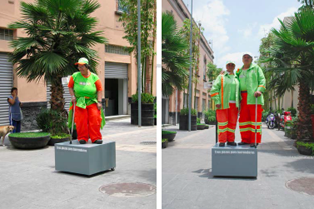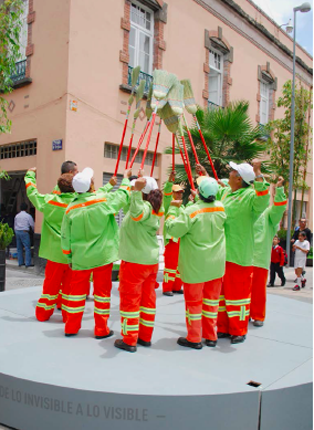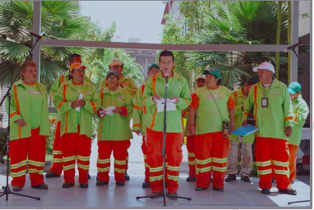 Three Pieces for Street Sweepers, Zócalo (pedestal). Photos by Pia Lanzinger. Three Pieces for Street Sweepers, Zócalo (pedestal). Photos by Pia Lanzinger.
 Three Pieces for Street Sweepers, Retrato de Grupo (Group Portrait). Photos by Pia Lanzinger. Three Pieces for Street Sweepers, Retrato de Grupo (Group Portrait). Photos by Pia Lanzinger.
 Three Pieces for Street Sweepers, Coro (Chor). Photos by Pia Lanzinger. Three Pieces for Street Sweepers, Coro (Chor). Photos by Pia Lanzinger.
|
"Three Pieces for Street Sweepers: From the Invisible to the Visible."
Mexico City has an undeniable garbage problem. But that does not mean that the streets are dirty. Quite the contrary: in the everyday street scene, the precarious situation of city wastes is almost unnoticeable. But the cleanliness of public road space lies not on the people who throw their rubbish into special container tanks or
that even separate it, but on the street sweepers. The cleanliness of many neighborhoods is thus not a sign of a solution to the garbage problem, but
it is closely associated with it.
The historic city center, a space bursting with restaurants and shops of all
kinds, shows that constant need for something new and the rapid devaluation of things, and it is here that an enormous amount of packaging material, bags, boxes and other litter is produced. Publicly but also undetected, hundreds of municipal cleaners work to make the ever-accumulating amount of waste to go unseen as quickly as possible. The problem of waste is also displaced.
Pia Lanzinger has come with the idea that one could read the rituals and prejudices associated with this displacement against the grain, and decided to cooperate with the street sweepers. Her project Three Pieces for Street Sweepers is attempting
a reversal: through staged performances the street sweepers (in the Centro Histórico, 60 percent of them women) would receive attention, both as respect for their function and in regard to their worth as persons.
The performances were carried out on different days during the months of June and July in the pedestrian zone at the corner of Regina Street and Mesones Alley. On three different stages, three classic sculptural genres were experimentally revisited, whereby, in addition to the individual and group portraits, a stage was used for a vocal performance that issues a festive statement for the event.
For the first piece, Zócalo, Lanzinger conducted interviews with several street sweepers about their personal histories and distilled from them two to three minute prose texts, which were then performed by professional narrators. Like statues standing on a pedestal, these pieces finally introduced the respective sweepers in public.
The second piece, Group Portrait, referring to the representation of entities or collectives, allowed the selfrepresentation of the street sweepers, a social group that tends to invisibility. Through several rehearsals the participants created different fi gures, in which they addressed especially their social position and the prejudices associated to it. For the performances, the artist placed a big round stage at their disposal.
The third and last piece, Chorus, offered the street sweepers the opportunity to compose and perform their own songs. Along with two professional musicians, they came up with a total of six songs, as well as some individual statements in which
the waste problem was tackled aggressively and playfully from the perspective of the sweepers. The purpose-designed rectangular stage was set three times, and the performances attracted on each occasion more and more attention from the
passers-by. The chorus, which was called The Invisibles, eventually convinced
the artist and the musicians involved with the idea of publishing the resulting songs.
The street sweepers were not the only ones to celebrate with great enthusiasm
their public performances. At least for a moment a spell was broken in this district, which is otherwise mainly used for tourism and consumption.
comment |


 Three Pieces for Street Sweepers, Coro (Chor).
Three Pieces for Street Sweepers, Coro (Chor).